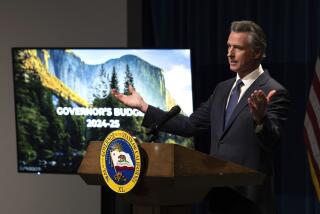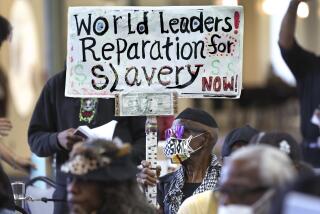The all-star economic task force advising Newsom during the pandemic remains a mystery

SACRAMENTO — Faced with a pandemic that has put millions of Californians out of work and eviscerated businesses large and small, Gov. Gavin Newsom promised that “health and science” would guide state officials in repairing the economy and steering it toward recovery.
But as Newsom rapidly reopened the state in May, he also received advice from an all-star roster of business titans. The Governor’s Task Force on Business and Jobs Recovery is a 108-member group that counts former California governors, Apple Chief Executive Tim Cook, Disney Executive Chairman Bob Iger and former Federal Reserve Board Chairwoman Janet L. Yellen among its members.
For all the boldface names and huge stakes, little is known about the task force, including how extensive a role the group played in shaping the decisions to reopen California.
The task force has operated almost entirely behind closed doors, and those appointed were not required to submit state government financial disclosure forms listing their assets and business interests, which would show potential conflicts. Newsom administration officials said the task force is just an advisory panel and has no authority to make policy, and noted that the meetings are private so members can share their opinions openly.
Second wave of coronavirus has businesses and the public moving from indoors to the great outdoors
Still, the governor has relied on the group’s recommendations to help shape his administration’s response to the COVID-19 pandemic. Members were consulted about safeguards for reopening retailers and other sectors of the economy, including guidelines calling for workers and patrons inside stores and other businesses to wear face coverings. The group has also urged Newsom to expand upon the $75 million set aside in the state budget for small-business loans.
Months after the governor called together the task force, however, few details about its work have been made public, falling short of Newsom’s pledge that the group would “demonstrate meaningful reforms, meaningful changes, working on bonds, working on all kinds of financial mechanisms to jump-start this economy.”
And what has been unveiled has been limited in scope. The task force told The Times it has reached out to internet service providers and computer suppliers to help bridge the “digital divide” among California students and asked them to offer affordable broadband access and donate devices, and it said that the group has worked on a training-based jobs program and marketing campaigns to help small businesses and slow the spread of the coronavirus.
Some in Sacramento say they are still waiting for the big ideas promised by Newsom when he announced the group in April.
“The idea was to bring California’s best minds and brainpower. What’s there to account for that?” said Steve Maviglio, a Democratic strategist who served as press secretary to then-Gov. Gray Davis. “Even Congress has been able to pass some economic stimulus — and California hasn’t. That makes no sense.”
Ann O’Leary, task force co-chair and Newsom’s chief of staff, said Californians can expect to see concrete initiatives from the group soon. She said the task force is discussing more long-range, big-ticket ideas to address issues related to the California economy, including racial inequities and combating climate change, and is exploring whether some of the beneficial side effects of the work and lifestyle changes caused by the pandemic, such as reduced traffic and pollution attributed to many Californians working from home, can be maintained in a retooled California economy.
“Leaders who we asked to help us really took the call to action seriously,” she said.
Since its creation, members of the governor’s task force — which also includes Los Angeles Times owner Dr. Patrick Soon-Shiong — have gathered every other week for a one-hour Zoom video call, with Newsom offering opening remarks. The panel has five subcommittees — focused on topics including small business, climate and infrastructure — that meet weekly.
Los Angeles developer Rick Caruso, a member of the task force, said that government advisory panels often lose steam over time and that those who are initially appointed as members have proxies attend in their place. That’s not been the case on this committee, he said.
“I think this has been one of the most productive [committees], and the reason is the governor has stayed very engaged,” said Caruso, who has served on the Los Angeles Board of Police Commissioners and the Los Angeles Memorial Coliseum Commission.
Jamie Court of the advocacy group Consumer Watchdog criticized the lack of transparency on the task force, which he likened to a “star chamber.”
“It’s the worst type of construct for the public because you don’t know what is being said and what information is being given to the governor,” Court said.
Most alarming, Court said, was the decision to appoint representatives from Southern California Edison and Aera Energy, a partnership of Shell Oil and ExxonMobil, who serve on the task force subcommittee for “leveraging innovation and climate.”
“It shows that this committee is being used to propagate the ideas of big business and not to target climate change proposals to actually limit the exploitation of the earth and the slowing of climate change,” he said.
Task force co-chair Tom Steyer, a billionaire former hedge fund manager, climate change activist and onetime presidential candidate, said members checked their personal and partisan interests “at the door.” Still, Steyer said, the task force members could have done a better job letting Californians know what they’ve been up to.
“This is an advisory group. The decisions are made by the governor,” Steyer said. “We’re bringing people to the table that reflect big businesses across California, little businesses across the board, every geographic area, community leaders and community groups and nonprofit leaders.”
Steyer said the panel has reviewed dozens of proposals to help kick-start California’s economy in an expeditious, long-lasting and equitable way. Steyer said he recently spoke to leaders in the solar and wind industries to see what can be done to accelerate their projects in ways that do not require state financial assistance.
“We are advising the governor on different financing options specifically in infrastructure, clean energy and bridging the digital divide,” Steyer said.
Micah Weinberg of California Forward, a nonprofit focused on improving government performance and economic growth, praised the proposals to accelerate infrastructure projects throughout California, noting that billions of dollars in previously approved bond money is readily available.
But he said the group should be doing more to address geographic and racial disparities in California’s economy and cultivate the growth of Black- and Latino-owned businesses.
“I think there’s an opportunity for more bold leadership … on some of these issues,” Weinberg said. “It strikes me as the time to be taking bigger risks to deliver for the people in California.”
The Newsom administration and the California Legislature need to provide measures that shield small businesses from liability claims and also thin out the thicket of state regulations that impede growth and investment, he said.
“If we’re serious about small businesses, and this is especially true for minority-owned small businesses, that’s going to have to be added to this agenda,” Weinberg said.
Task force member Angela Glover Blackwell, the founder of PolicyLink, a nonprofit group that promotes policies to help disadvantaged Americans, said the COVID-19 pandemic has only exacerbated the devastating consequences of racial inequity in California.
Not only are Black and Latino people more likely to be part of the essential workforce, they’ve been disproportionally hit by the virus itself. Black, Latino and rural students are less likely to have internet access at home, which will lead to dire consequences when most California schools begin the academic year with closed classrooms and distance learning, Blackwell said.
“The issues are bigger than tax breaks for small business,” she said.
Blackwell added that more proposals are coming and that the task force, given the large size of its membership and what it is trying to accomplish, is working “well enough.”
Economist William Yu of the UCLA Anderson School of Management said that of the ideas from the task force, accelerating infrastructure projects may be the easiest and most effective way to stimulate the state’s economy. But he said rescuing businesses and the workforce depends mostly on the federal government’s response.
The Coronavirus Aid, Relief and Economic Security Act, a $2-trillion bipartisan stimulus package signed in March by President Trump, provided special unemployment benefits and offered small businesses critical financial assistance at the height of the pandemic. But the benefits expired at the end of July, and a new financial relief package has stalled in Washington.
Yu said it’s essential that Congress act quickly and decisively.
“Otherwise we’re going to see what happened in the early 1930s in the Great Depression,” he said.
More to Read
Sign up for Essential California
The most important California stories and recommendations in your inbox every morning.
You may occasionally receive promotional content from the Los Angeles Times.












